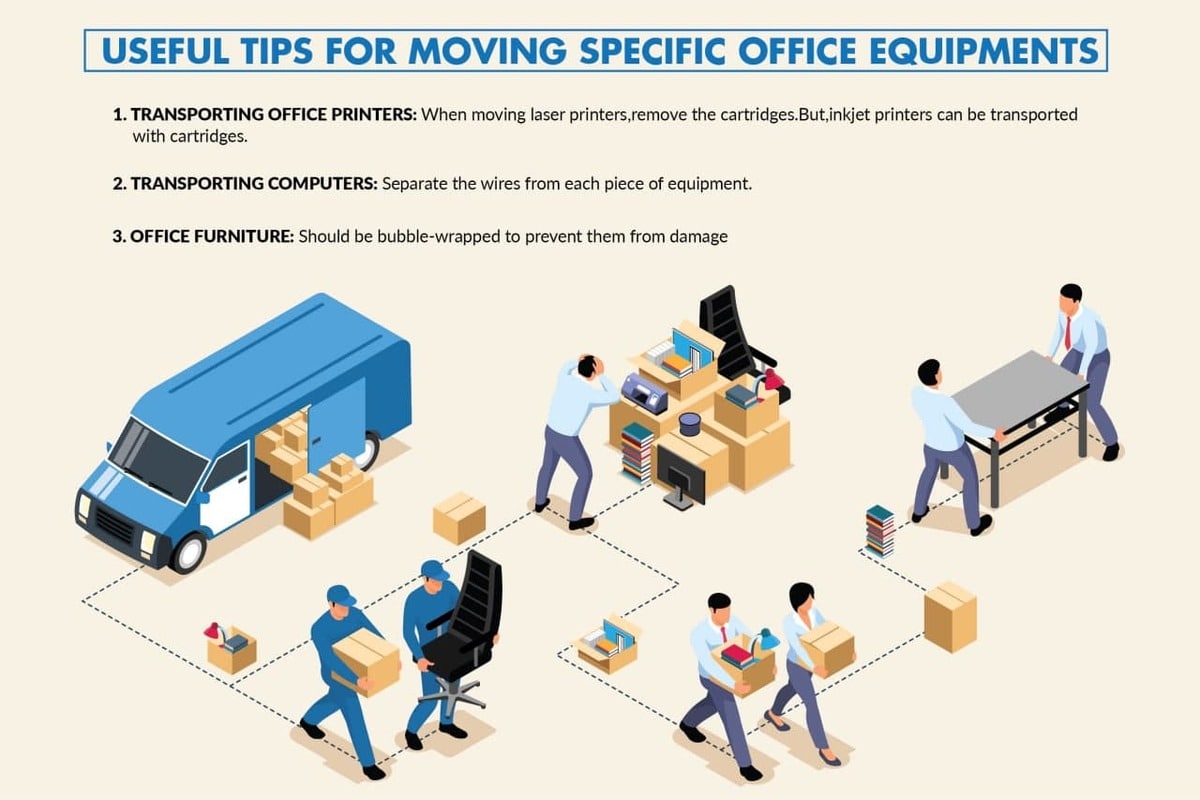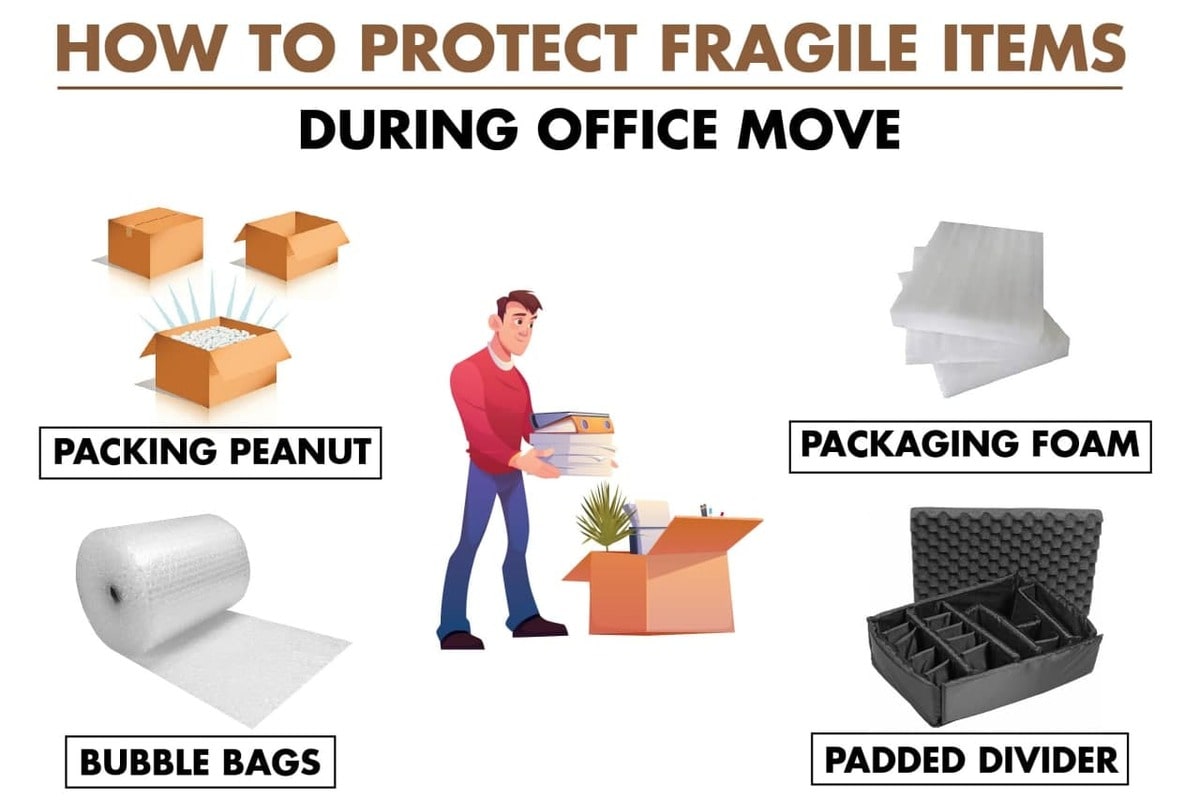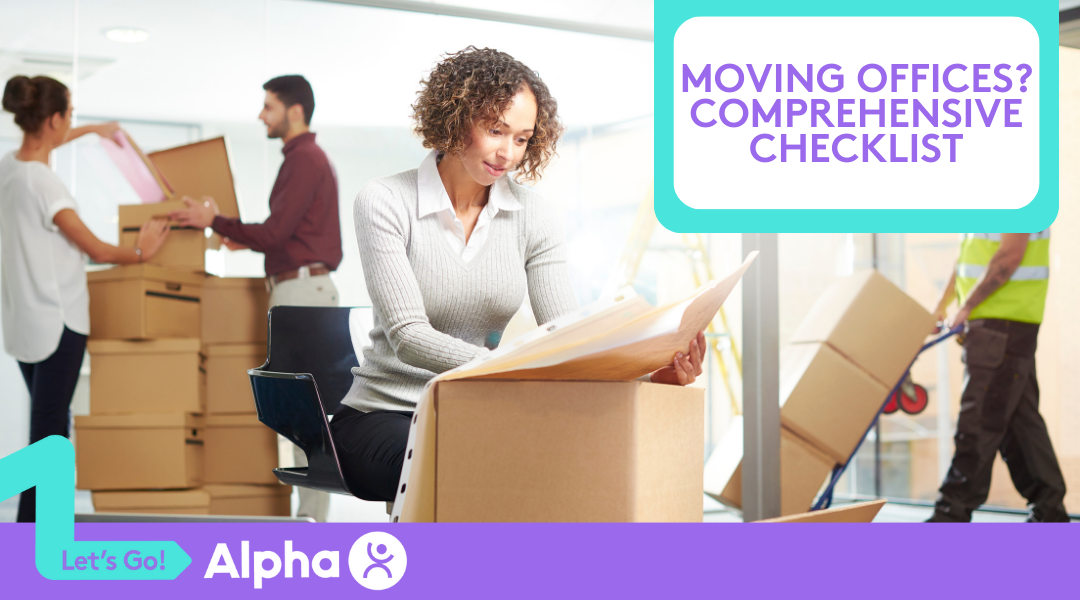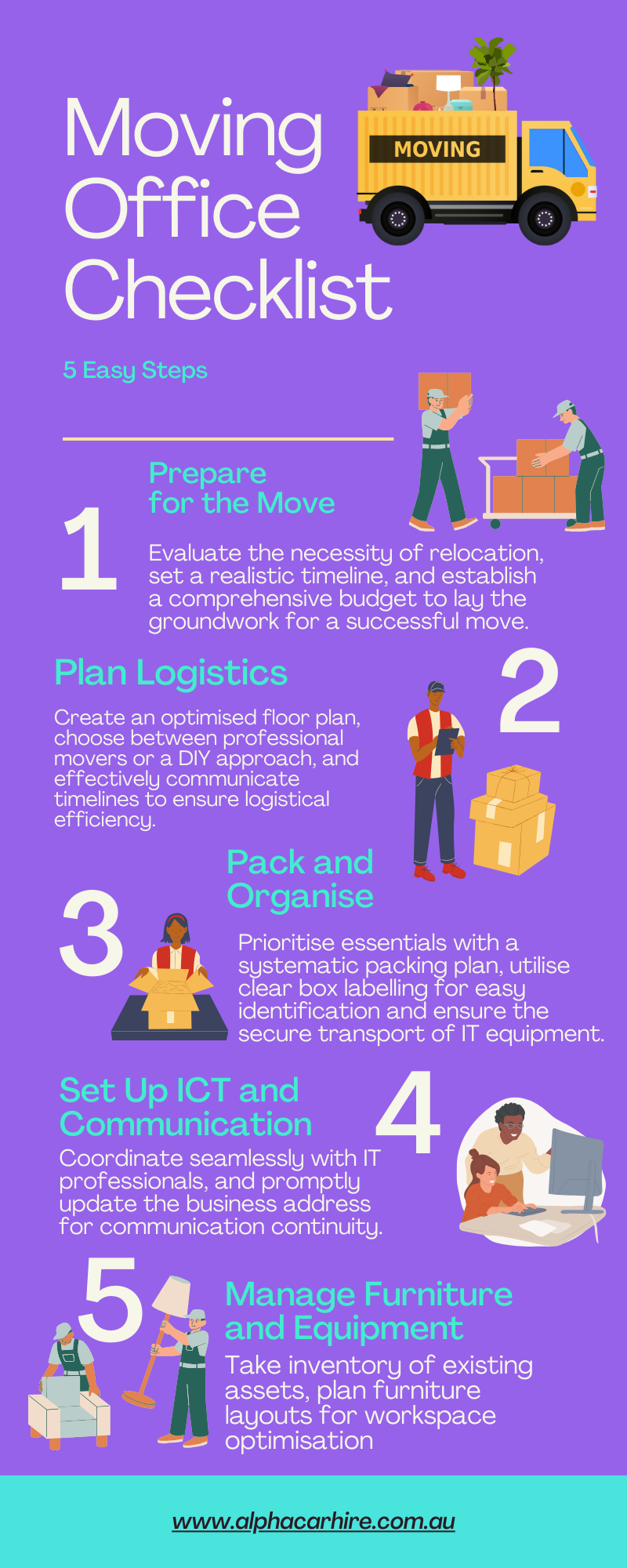Moving your office is more than just a change of scenery; it’s a strategic transition that can significantly impact your operations. A seamless relocation is crucial for maintaining productivity, minimizing downtime, and bolstering employee morale. This comprehensive guide, your one-stop shop for an efficacious office move, addresses every aspect: from pre-move planning and logistics management to meticulous packing and post-move employee support.
Free Downloadable Checklist: For your convenience, we’ve included a downloadable checklist that summarizes the key steps involved in a successful office move. You can find the link to the checklist at the end of this guide.
Step 1: Preparing for the Move
1. Assess the Need for Relocation:
Before diving into logistics, delve into the reasons behind your move. Understanding your motivations is crucial for making informed decisions.
- Expansion Plans: Evaluate if your current space can accommodate future growth. Is relocating for expansion a necessity, or can strategic space optimization solutions address your needs?
- Accessibility: Consider the new location’s accessibility for both employees and clients. Proximity to transportation hubs, amenities, and parking can significantly influence daily operations.
- Impact on Growth Trajectory: Ensure the move aligns with your business’s long-term goals. Does the new location offer the infrastructure and environment necessary to support your strategic objectives?
2. Set a Realistic Timeline:
A realistic timeline considers key factors that impact the move’s duration.
- Milestones: Identify critical milestones, including lease negotiations, packing, moving day, and post-move adjustments.
- Planning Phase: Allocate ample time for meticulous planning. This allows for the development of a comprehensive strategy and the identification of potential challenges.
- Post-Move Adjustments: Factor in time for employees to adjust to their new environment.
3. Establish a Budget for the Move:
Financial planning requires a detailed examination of various cost factors:
- Leasing or Purchasing Costs: Consider location, size, amenities, and whether leasing or purchasing new office space is a better financial fit.
- Logistics Services: Be transparent in budgeting by calculating the costs of hiring professional movers or using a DIY approach.
- Renovations or Upgrades: Budget for improvements that align with your office requirements. Anticipate any necessary renovations or upgrades to the new space.
- Contingency Fund: Include a contingency fund to address unexpected expenses that may arise during the relocation process.
Step 2. Planning Logistics
1. Create a Floor Plan for the New Office:
Optimising the new office space involves a comprehensive approach to layout and design:
- Workstations Allocation: Plan the strategic allocation of workstations to enhance collaboration and workflow efficiency.
- Common Areas and Facilities: To create a well-balanced and functional office environment, designate spaces for common areas; and meeting rooms–essential facilities are also crucial.
- Employee Input: To promote a positive work environment, it is imperative that we actively seek input from employees: this will not only ensure their needs are accommodated by the floor plan but also foster an atmosphere conducive to productivity and satisfaction.
- Floor Plan Design: Create a functional floor plan for the new office. Consider workstation allocation for optimal workflow, designate common areas and essential facilities (meeting rooms, break rooms), and actively seek employee input on the layout.
- Moving Services: Decide between professional movers for complex relocations or a DIY approach with vehicle rentals, packing materials, and logistical coordination. Consider insurance coverage for potential damages during the move.
- Communication Strategy: Implement a clear communication strategy with advanced notice to employees and stakeholders. Share the relocation timeline and conduct informational sessions to address concerns. Offer employee support and maintain stakeholder engagement throughout the transition.
2. Hire Professional Movers or Coordinate DIY Move:
Choosing between professional movers and a DIY move involves additional considerations:
- Office Size and Complexity: Determine if professional movers, indeed, are better equipped to handle the specialised requirements of your office; evaluate the size and complexity–particularly through a graduate-level analysis involving colons, semi-colons and dashes:
- Budget Constraints: Consider your budget constraints; then, obtain quotes from a multitude of moving companies: this will allow you to compare not only costs–but also services.
- Logistical Support: Evaluate the logistical support necessary for a do-it-yourself move; this assessment should encompass three key aspects: vehicle rentals, packing materials, and coordination efforts.
- Insurance Coverage: Verify insurance coverage options to safeguard against potential damages or losses during the move.
Consider contacting Alpha Car Hire for reliable and convenient solutions, offering a diverse fleet of vehicles suitable for various moving needs, including moving vans and trucks.
3. Notify Employees and Stakeholders:
Effective communication during the relocation process is pivotal for a smooth transition:
- Advanced Notice: Allow employees and stakeholders advanced notice: this will provide them with ample time to prepare for the impending move.
- Relocation Timeline: Communicate the relocation timeline, including key dates and milestones, to manage expectations.
- Informational Sessions: Conduct informational sessions to address any concerns and provide additional details about the move.
- Employee Support: We provide support services that address both the logistical and emotional challenges employees face during a move, ultimately guaranteeing a positive experience for our workforce.
- Stakeholder Engagement: During the transition, actively engage key stakeholders–clients and partners in particular: this ensures not only transparent communication but also effective relationship management.
Step 3: Packing and Organisation
1. Develop a Systematic Packing Plan:
The cornerstone of a seamless relocation process is efficient packing. To systematically organise the packing process, consider these steps:
- Prioritise Essential Items: Identify and prioritise–with a focus on immediacy–the essential items for use in our new office. By doing so, we can guarantee an uninterrupted transition; furthermore, this approach will minimise any potential disruptions to our daily operations.
- Detailed Packing Plan: Formulate a comprehensive packing strategy: this plan should delineate specific tasks, establish defined timelines–and allocate responsibilities to each team member. A structurally sound blueprint enhances not only coordination but also efficiency throughout the entire packing phase.
- Colour-Coded Labels or Numbering Systems: To streamline the unpacking process and expedite locating specific items, we recommend implementing a system: of colour-coded labels or numbering. This categorises and identifies boxes based on their contents as well as designates destination areas within your new office.
2. Label Boxes Clearly for Easy Unpacking:
For a smooth and organised unpacking process at the new office, efficient labelling proves pivotal. Here’s an effective method:
- Clear Content Descriptions: Label each box with a clear, detailed description of its contents; this practice streamlines the unpacking process and enables employees to swiftly locate specific items.
- Designated Areas in the New Office: Please designate the specific area in the new office for each box; this strategic labelling system–by reducing confusion and guaranteeing placement at their intended locations–proves incredibly effective.
3. Safely Pack and Transport IT Equipment:
When handling IT equipment, one must exercise special care to avert damage or data loss during transit. Ensure the safe packing and transportation of sensitive electronic devices by following these methods:
- Use Appropriate Packing Materials: To safeguard fragile IT equipment from potential damage inflicted by shocks or vibrations during transit, employ anti-static bubble wrap, cushioning and other suitable packing materials; this method is highly effective.
- Consider Specialised Movers or IT Professionals: Consider the added assurance of hiring specialised movers or IT professionals, experienced in managing sensitive equipment; their expertise not only reduces operational disruptions but also guarantees secure transportation and reinstallation of your IT assets.

Step 4. Technology and Communication Setup
1. Coordinate with IT Professionals for Seamless Transition:
Crucial for the continuity of business operations is the meticulous assurance of a seamless technology and communication systems transition; this necessitates graduate-level expertise in managing complex infrastructural changes–a key responsibility incumbent upon any strategic leader.
- Engage IT Professionals: Ensure a seamless transition of our technology infrastructure by coordinating with IT professionals. The expertise these individuals possess guarantees efficient relocation and re-establishment of systems in the new office space.
- Transfer Data and Settings: Collaborate closely with IT professionals: together, your objective is to transpose vital data and settings into the novel office environment–a crucial step that reduces downtime. More than just a task, this action guarantees seamless continuity in daily business operations.
2. Update Address for Business Communications:
Maintaining clear communication channels during the move is essential:
- Update Business Address: Make sure to update your business address on all communication channels: these encompass email signatures, business cards – and any other platform employed for business discourse.
- Notify Clients and Partners: Clients, partners, and relevant stakeholders must receive notification of the address change. This proactive transparency ensures uninterrupted communication and upholds a professional image.
3. Ensure Internet and Phone Services are Set Up:
To achieve business success, one must prioritise seamless connectivity. Therefore, it is imperative to guarantee an effortless transition for both internet and phone services:
- Coordinate Installation: Before the move, actively coordinate with service providers to set up and ensure operational internet and phone services in the new location. This approach ensures zero downtime in communication through its proactive nature.
- Test Connectivity: Thoroughly test the functionality of internet and phone services in the new office; promptly address any issues to circumvent disruptions to business communication.
Step 5: Furniture and Equipment:
1. Inventory Existing Furniture and Equipment:
A systematic approach to managing furniture and equipment streamlines the relocation process:
- Conduct a Comprehensive Inventory: This will function as your touchstone during the processes of packing, unpacking and orchestrating the new office.
- Evaluate Condition: Pinpoint any that might necessitate repairs, replacement or special handling during relocation.
2. Decide on the Furniture Layout in the New Office:
Planning the layout of furniture in the new office enhances productivity through efficient space utilization; therefore, we must:
- Consider Workflow: Prioritise the design of the furniture layout based on the new office space’s workflow and functional requirements; emphasize collaborative areas, while optimising individual workstations.
- Employee Input: Ensure your inclusive approach by seeking employees’ input on the furniture layout. This strategy guarantees alignment of the new office environment with workforce needs and preferences.
3. Arrange for the Disassembly and Reassembly of Furniture:
Proper handling of furniture is essential for a smooth transition:
- Coordinate Disassembly: Ensure each piece of furniture receives appropriate labelling for easy reassembly; coordinate with professionals or internal teams to disassemble it.
- Professional Reassembly: Enlist the services of professionals for potentially reassembling furniture in the new office; their expertise guarantees a safe and efficient reconstruction.

Step 6:. Utilities and Services
1. Coordinate with Utility Providers for Disconnection/Reconnection:
- Efficiently manage utility services during the relocation process:
- Schedule Disconnection: Please, coordinate with the utility providers: and schedule a disconnection of services at our current location on an appropriate date.
- Ensure Seamless Reconnection: Devise a plan to seamlessly reconnect the utilities at our new location. Ensure that service activation dates align with our move-in schedule.
2. Update Business Address with Service Providers:
Maintain accurate records with service providers:
- Notify Service Providers: Inform insurance, security, and maintenance service providers of the business address change. This step guarantees their possession of current information for billing and service-related activities.
- Verify Contracts: Ensure the review of current contracts with service providers: update their terms and conditions to accurately reflect our new office address.
3. Set Up Necessary Services in the New Location:
Proactively prepare the new office space for operations:
- Coordinate Service Installation: Coordinate with service providers for the installation of necessary services at the new location: this involves security systems; cleaning services–and any other operational service deemed essential.
- Test Services: Thoroughly test the functionality of newly installed services; promptly address any identified issues. This approach will ensure a seamless start in the new office.
Step 7. Employee Support:
1. Provide Employees with Moving Guidelines:
Supporting employees through the relocation process is essential for a smooth transition:
- Clear Moving Guidelines: Furnish employees with meticulous, exhaustive moving guidelines: these should encompass packing suggestions; instructions for the day of relocation–and provide helpful advice on settling into our novel office space.
- FAQs and Support: Anticipate the common questions, and address them in a Frequently Asked Questions (FAQ) document; moreover—provide a point of contact for personalised support: this strategy aims to effectively address individual concerns.
2. Offer Assistance with Temporary Housing if Necessary:
Understanding the diverse needs of employees contributes to a positive relocation experience:
- Temporary Housing Options: Offer employees who may require temporary housing during the transition: assistance or resources. By providing information about local accommodation options–we can alleviate some of the stress associated with this move.
- Guidance on Housing Benefits: Ensure the clear communication of all available housing benefits or support programs to employees; this provision is instrumental in empowering individuals to make informed decisions about their temporary living arrangements: it capacitates them with the necessary knowledge and resources for an optimal housing experience–a crucial aspect of overall job satisfaction.
3. Communicate Frequently to Address Concerns:
Open and frequent communication is key to addressing employee concerns:
- Establish Communication Channels: Establish robust communication channels: these may comprise regular meetings–a dedicated platform for addressing employee concerns is also recommended. Promote an environment of open dialogue; it is essential that employees feel not just comfortable, but encouraged to articulate their thoughts.
- Address Concerns Promptly: Listen actively to the concerns of employees; promptly address them. By ensuring timely communication–an action that fosters trust and guarantees a sense of support for all staff members throughout the relocation process–you demonstrate your commitment towards their well-being.
Step 8: Legal and Compliance Considerations
1. Update Business Licenses and Registrations:
Maintaining legal compliance is crucial for the continuity of business operations:
- Review and Update Licenses: Review existing business licenses and registrations to ensure they reflect the new office address. Promptly update these documents to comply with legal requirements.
Notify Regulatory Authorities: Notify relevant regulatory authorities about the change in office location. Complying with legal obligations prevents potential issues and disruptions.
2. Comply with Local Zoning and Building Regulations:
Adhering to local zoning and building regulations is essential for a smooth relocation:
- Verify Zoning Requirements: Verify that the new office location complies with local zoning regulations. Address any necessary approvals or permits to ensure compliance with local laws.
Building Code Compliance: Ensure that the new office space adheres to building codes and regulations. Compliance minimises the risk of penalties and ensures a safe and legal workplace.
3. Address Legal Documentation for the New Office:
Reviewing and updating legal documentation safeguards the business’s interests:
- Lease Agreements and Contracts: Review and update lease agreements and contracts associated with the new office space. Ensure that legal documentation accurately reflects the terms and conditions of the relocation.
- Employment Contracts: Update employment contracts, if necessary, to reflect the change in office location. This ensures that employees are aware of any modifications to their work arrangements.
Step 9: Post-Move Settling In
1. Unpack and Organise Efficiently:
Efficient unpacking ensures a swift return to regular business operations:
- Prioritise Essential Items: Begin unpacking by prioritising essential items needed for immediate business operations. This strategic approach minimises downtime.
- Team Collaboration: Encourage team collaboration during the unpacking process. Assign specific tasks to different teams or individuals to streamline the organisation of the new workspace.
2. Conduct a Post-Move Evaluation with Employees:
Gathering feedback is essential for continuous improvement:
- Employee Feedback Sessions: Conduct post-move evaluation sessions with employees to gather insights on their experience. Encourage open discussions to identify areas for improvement and address any lingering concerns.
Identify Successes and Challenges: Identify both successful aspects of the move and any challenges encountered. This information serves as valuable input for refining future relocation processes.
3. Celebrate the Successful Office Transition:
Acknowledging the achievement of a successful transition boosts morale:
- Recognition and Appreciation: Recognise and appreciate the efforts of employees throughout the relocation process. Celebrate milestones and express gratitude for their contribution to the successful office transition.
- Team Building Activities: Organise team-building activities or events to foster a sense of camaraderie and unity in the new office. These activities contribute to a positive workplace culture.
Free Downloadable PDF Moving Checklist:

To enhance your moving experience, we present a comprehensive Moving Office Checklist in a convenient PDF format. This downloadable resource is crafted to keep you organised, ensuring no crucial step is overlooked during your relocation.
What the PDF Includes:
- Detailed step-by-step guide for each phase of your move.
- Printable checklist to mark off tasks as you complete them.
- Tips and reminders for a smooth and stress-free relocation.
Make your move more efficient and organised by utilising our Free Downloadable PDF Moving Office Checklist. Click the button below to download:
Logistics and Transportation
Contact Alpha Car Hire for Moving Trucks and Vans:
For efficient transportation during your office move, rely on Alpha Car Hire:
- Diverse Fleet: Choose from a variety of trucks and vans to match your moving needs.
- Flexible Rentals: Enjoy flexible options tailored to your timeline, whether short-term or long-term.
- Reliable Fleet: Count on a well-maintained fleet for secure and smooth transportation.
- Easy Booking: Conveniently book online or through customer service, streamlining the logistics.
- Dedicated Support: Benefit from Alpha Car Hire’s customer support for assistance and special requests.
For a hassle-free transportation solution, contact Alpha Car Hire and ensure a seamless relocation experience.
Frequently Asked Questions About Moving Offices
Q: What is the first step when planning an office move? A: The first step is to establish a clear timeline and budget. This involves assessing your current needs, deciding on a realistic schedule, and setting a financial plan for the relocation.
Q: How do you make an office move stress-free? A: A well-organised, step-by-step approach is key to a stress-free office move. The process includes planning logistics, creating a detailed checklist, and maintaining open communication with your team and stakeholders.
Q: Should I hire professional movers or do it myself for an office move? A: The decision depends on your budget, resources, and the amount of equipment you have. While professional movers can handle the heavy lifting and logistics, a DIY approach with hired moving trucks or vans, like those available from Alpha Car Hire, can be more cost-effective for smaller moves.
Q: How do I get a moving truck or van for my office move in Brisbane? A: You can hire moving trucks and vans from Alpha Car Hire. They offer a range of commercial vehicles to suit your needs, and you can pick up your hire vehicle directly from their Brisbane branch.
Q: Do I need to update my business licences when I move offices? A: Yes, it is a crucial legal step to update your business licences and other compliance-related documentation to reflect your new office address. This is part of the legal and compliance considerations for any office relocation.





